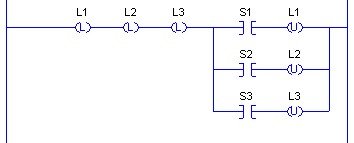ydtech has raised a good point.
All too often I have seen test and exam questions, homework assignments, course material, clients specifications, functional specifications, et al, that have this "incompleteness" or "ambiguity".
When I saw the original "specification", I turned it on it's head, and decided that a simple solution would be for all lamps to be on initially, and that S1 turns off L1, S2 turns off L2, and S3 turns off L3. See the pic for my "solution", which I post merely for educational purposes. I believe it meets the requirements of the question as given, but only if each statement is tested individually. However, the "question" causes ambiguities about the state of the lamps when coded into a PLC. The question did not specify the "all-off", "all-on", or even 2 on together.
In my opinion, this is a BAD way to teach the fundamentals of PLC programming, unless of course the "questioner" was hoping that students would see the ambiguities. However, in this case there should have been follow-on questions like "What happens if more than 1 switch is pressed". Without those follow-on questions, students will not learn the way PLCs work, and will continue to make basic mistakes.
Now I wonder if I would have been marked down for presenting a ladder solution that met the requirements of the question, but didn't meet the requirements of the questioner.
PS. My ladder solution is done in Logix5000, which allows the (to some) strange logic constructs, such as serial output instructions, and their placement on the rung.








